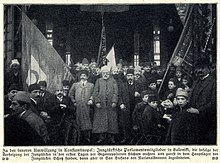 Global Information
Global Information31 March incident information
| 31 March incident | |||||||
|---|---|---|---|---|---|---|---|
 Deputies of the parliament in Thessaloniki | |||||||
| |||||||
| Belligerents | |||||||
| Action Army |
Hunter Battalions revolting against their officers in Istanbul.
| ||||||
| Commanders and leaders | |||||||
|
Mahmud Shevket Pasha Ahmed Niyazi Bey Enver Pasha |
Abdul Hamid II | ||||||
The 31 March incident (Turkish: 31 Mart Vakası) was a political crisis within the Ottoman Empire in April 1909, during the Second Constitutional Era. The incident broke out during the night of 30–31 Mart 1325 in Rumi calendar (GC 12–13 April 1909), thus named after 31 March where March is the equivalent to Rumi month Mart. Occurring soon after the 1908 Young Turk Revolution, in which the Committee of Union and Progress (CUP) had successfully restored the Constitution and ended the absolute rule of Sultan Abdul Hamid II (r. 1876–1909), it is sometimes referred to as an attempted countercoup or counterrevolution. It consisted of a general uprising against the CUP within Istanbul, largely led by reactionary groups, particularly Islamists opposed to the secularising influence of the CUP and supporters of absolutism, although liberal opponents of the CUP within the Liberty Party also played a lesser role. The crisis ended after eleven days, when troops loyal to the CUP restored order in Istanbul and deposed Abdul Hamid.
The crisis began with a mutiny among elite Macedonian troops of the Istanbul garrison on the night of 12–13 April 1909 (R.C. 30–31 Mart 1325), sparked by agitation from Muslim fundamentalists, low morale and officerial mismanagement. The unrest spiralled out of control as religious students and other elements of the city's garrison joined the insurrection, converging on Ayasofya Square to demand the re-establishment of Sharia. The CUP-aligned government of Grand Vizier Hüseyin Hilmi Pasha responded ineffectually, and by the afternoon of 13 April its authority in the capital had collapsed. The Sultan accepted Hilmi Pasha's resignation and appointed a new cabinet free from the CUP's influence under Ahmet Tevfik Pasha. Most CUP members fled the city for their power base in Salonika (modern Thessaloniki), while Mehmed Talaat escaped with 100 deputies to San Stefano (Yeşilköy),[1] where they proclaimed the new ministry illegal and attempted to rally secularists and minorities in support of their cause. For a brief period the two rival authorities in Istanbul and Aya Stehano each claimed to represent the legitimate government. These events triggered the Adana massacre, a month-long series of anti-Armenian pogroms organised by local officials and Islamic clerics in which 20,000 to 25,000 Armenians, Greeks and Assyrians were killed.
The uprising was suppressed and the former government restored when elements of the Ottoman Army sympathetic to the CUP formed an impromptu military force known as the Action Army (Hareket Ordusu), which entered Istanbul on 24 April after failed negotiations. On 27 April, Abdul Hamid, accused by the CUP of complicity in the uprising, was deposed by the National Assembly and his brother, Mehmed V, made sultan. Mahmud Shevket Pasha, the military general who had organised and led the Action Army, became the most influential figure in the restored constitutional system until his assassination in 1913.[2]
The precise nature of events is uncertain; differing interpretations have been offered by historians, ranging from a spontaneous revolt of discontents to a secretly planned and coordinated counter-revolution against the CUP. Most modern studies disregard claims the sultan was actively involved in plotting the uprising,[3] emphasising the CUP's mismanagement of troops in the build up to the mutiny and the role of conservative religious groups.[4] The crisis was an important early moment in the empire's process of disintegration, setting a pattern of political instability which continued with military coups in 1912 and 1913. The temporary loss of power led to radicalisation within the CUP, resulting in an increasing willingness among unionists to utilise violence.[5] Some scholars have argued that the deterioration of ethnic relations and erosion of public institutions during 1908–1909 precipitated the Armenian genocide.[6]
- ^ Kieser 2018, p. 72.
- ^ Shaw 1976, p. 282.
- ^ Swenson 1970, p. 171.
- ^ Gingeras 2016, p. 36.
- ^ Gingeras 2016, p. 38.
- ^ Der Matossian 2011, p. 152.